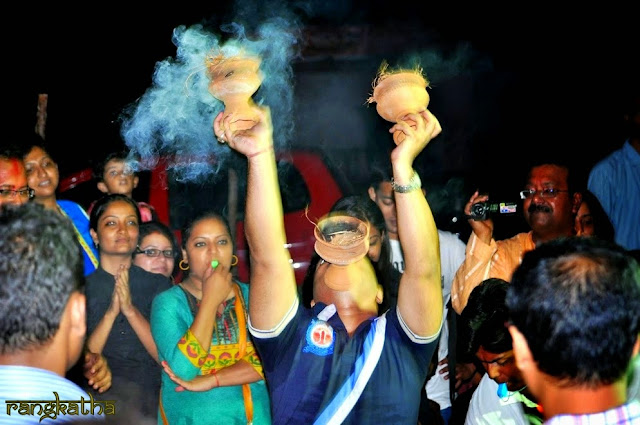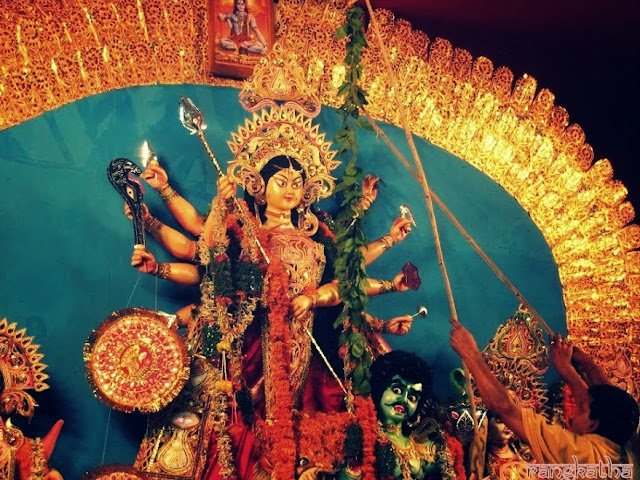This season, when I thought of a post on Durga Puja, I couldn't have thought about anyone but Mallika who could have done justice to this post. Reason is not just her Bengali background. Since the time I have known her, my only view of Durga Puja is through her Puja celebrations. Then of course what can be more descriptive than hearing from a Bengali the real essence of Durga Puja..
So here, I pass it on to Mallika, who is here to describe how she is been celebrating Durga Puja for years and what does this Puja mean to her and her family....
PC: All pictures are taken either by Mallika, her daughter Penaaz or her family and friends. Images are from and during Puja celebrations Mallika attended over the years and content includes herself, her family and friends and are subject to copyright. Please do not use them.
~ Prasanna
Essence of Durga Puja - by: Mallika Sen Ali
As I sat browsing through Facebook my friend Prasanna messaged me. With the Durga puja approaching she asked me if I would write a post for her blog about how we Bengalis celebrate Durga Puja. I agreed instantly for two reasons, you can’t refuse Prasanna when she sweetly requests you something and secondly, the topic was so close to my heart.
Making of Idol of Goddess Durga!
We Bengalis wait for the Puja with bated breath every year. The yearlong wait for those five days of the year culminates into euphoria that you have to see and feel to believe. As the day of Mahalaya arrives, setting the tone for the Puja, we get up as early as 4 am to listen to Mahisasur Mardini on good old AIR or whichever media suits you.
This is followed by Pitru Tarpan (offerings to the fore fathers, as Mahalaya also brings about the end of Pitru Paksha). Mahalaya also means the Puja is almost at your doorstep with just 5 days away. Yes 5 days, even though the Navaratris as celebrated by the people from North India starts from the very next day, we Bengalis start our celebrations from the 5th.
Goddess in full glory - this decor is known as Chumki Saaj
As kids, Durga Puja meant a month long practice and rehearsals for the cultural programmes. I often wonder now where did we get so much energy during those practice days as the whole day we will be in school dealing with studies and other physical activities. Yet once back home we will just race through the homeworks and assignments to go for the rehearsals. And by the time we would return from the rehearsals it will be close to midnight. Yet that joy and excitement was and still is unparalleled.
Mornings will be spent doing puja, offering pushpanjali and eating prasads. Prasad used to taste heavenly as we would be fasting till the pushpanjali is done, and then there will be this mad rush for the Prasad followed by a hearty breakfast.
As we grew up, the perspective changed a bit, but the core of it remained the same. Puja is about meeting up friends, having long addas (a typical term for Bengalis, describing discussions ranging from food, politics, basically anything under the Sun). And in this entire melaa there will be a dedicated team of aunties and grannies doing the Puja with full fervor.
Aarti
Blowing the Shonkho (conch), integral part of Puja
Goddess in Daak-er Saaj deco.
Another one with Daak-er Saaj or the deco with Shola
With the “bodhan” or the invocation of Goddess done, Saptami morning sets the pace for the Puja with the welcoming of Goddess Durga along with her children Ganesha and Kartika and sakhis Goddess Laxmi and Saraswati amid chanting of hymns followed by the Pushpanjali (floral offering to the Goddess) and Bhog (food or the Prasad offered to the Goddess) and arati.
Goddess along with her kids Ganesha and Kartika and sakhis Laxmi and Saraswati
Pooja in progress...
Afternoons are leisurely and are spent catching up with friends and also indulging in some cultural and creative exchanges. For kids there will be competitions like sit and draw, debates, solo or group vocals or a simple GK quiz. As the evening approaches it’s time for Sandhya Arati with the Dhakis (drummers) exhibiting their drumming skills and a small group of people comprising kids and adults dancing to the beats with dhunachi (Indian incense burners). Dhunachi Dance is one of the main attractions during the sandhya arati across all the 5 days. Now-a-days even there are competitions for the same.
Dhunachi Dance...
Come Ashtami morning, people dress up in their best for the day. Office goers take a break as it is believed and practiced that you should not miss the
pushpanjali of Ashtami. Puja pandals across the Nation sees the biggest crowd on Ashtami, so a D-day for the organisers too. It is also the day for Kumari puja
(where the Goddess is worshipped in the form of a small girl), you can see little girls as young as 4 or 5 yrs wearing saris.
Little girl wearing saree offering pushpanjali.
There will be a serpentine queue in front of the Mahabhog counter as on this day most Bengalis go vegetarian relishing the khichudi (preparation of rice and lentils cooked together with a select tempering and loaded with Ghee) with Labda (a mixed vegetable preparation) accompanied by chutney (sweet n sour preparation of tomato) and payesh (sweet pudding made of rice and milk).
As the day progresses amid the chants and the pushpanjalis, for the ladies handling the puja preparations, there’s a mad rush in arranging for the Sandhi
Puja, it’s a 48 minutes puja which comprises of 24 minutes of Ashtami and 24 minutes of the Navami tithi (lunar cycle). The line-up for this puja is immense
as everything that is being offered including the Bhog or the number of Lotuses to the number of earthen lamps or diyas have to be 108. It needs expertise to
handle the arrangements for this puja, as the timing is crucial.
108 lotuses offered in garland form during Sandhi Puja.
108 earthen lamps being prepared ....
And lit during Sandhi Puja
Lotuses can also be offered after being opened
Garland made out of 108 Bilwa patra
Prasad or bhog in count of 108 offered during sandhi puja
You wish for well being of the family while lighting the lamps during Sandhi Puja
Evenings are usually relaxed as after the Sandhya arati it’s time to enjoy the cultural shows. The day of Navami brings a sad tone to the celebrations as it means that the celebrations are coming to end and again there will be a yearlong wait for the next puja.
Navami puja comprises of Hom-Yagna and Chandipath.The morning of Bijoya Dashami is a treasured time for the ladies of the community. At the end of Dashami puja and Darpan Visarjan(a ritual where the image of the goddess is captured in a mirror placed in a bowl full of water and once the puja is completed the mirror is slid inside the water symbolically immersing the idol).
Dashami puja
Darpan Visarjan
On this auspicious day the married ladies offer Sweets and Sindoor (red vermillion powder)to the Goddess Durga as a part of traditional ritual and pray for the well being of their family and the community. They also caress the face of Durga idol with the help of “pan pata” (betel leaf).
This is followed by Sindoor utsav where ladies apply sindoor to each other and trust me it does get frenzied.
As the evening approaches the atmosphere is engulfed in the sad tone of immersion of the idols signifying their return to their abode. Dancing and rejoicing to the beats of Dhak people proceed towards the immersion ghats. It is a bittersweet moment when the idols are put in water. We return with a renewed vigour and start planning for the Puja next year.
Tearful sendoff - Visarjan
Well, I think have been able to sum up the Puja for you all from a Bengali perspective. Have not really touched on the legends behind the Puja as it is available in bounty over the Internet. In short for a Bengali, Durga Puja means a time to catch up with friends, a time for a cultural exchange and feasting (yes, what is a Bengali or should I say Bong without the mention of food). Yes I know, you would say that I didn’t really say much about food here, agree to that, because if I start I can go on and on for many pages here. So, sparing you that torture for this time. May be some other time probably ;)
~Mallika Ali Sen
































Such a beautiful post...visually stunning and I got to know do much about Durga puja. I have never attended one so this was very informative. Thanks Prasanna and Mallika.
ReplyDeleteThank you Nayana! I have never attended one before either and this post is been a cherishing learning experience for me as well. Now I do wish to celebrate at least one puja together with Mallika and hopefully Maa Durga will facilitate this soon:)
DeleteThank you Nayana for liking the post :)
ReplyDeletePrasanna, will be looking forward to spending Puja with you someday :)
Reading this post was like walking down memory lane and reliving my days in Calcutta (18 years ago) when I used to live there. And the timing is so apt. Thank you Prasanna and Mallika for bringing a bit of the Durga Pooja joy into my home, too. xx
ReplyDeleteThank you for stopping by Arti! Happy to hear about your ties to Calcutta, this city has a special place in my heart for various reasons. Visited many times myself:)
Deleteblog hopped here and loved this post!
ReplyDeletewhat a beautiful way to tell a story with such powerful images!
learnt so much too!
~deepa
Welcome to Rangkatha Deepa, happy to see you here ! Mean a lot coming from you that you loved the post.. Keep visiting:)
DeleteMa Durga Bisarjan 15th October 2021
ReplyDelete"DARPAR VISARJAN"
Nurse salaries in Saudi Arabia are influenced by factors like experience, qualifications, and the type of healthcare facility. Entry-level positions typically offer around SAR 5,000 to SAR 8,000 monthly, with potential earnings of over SAR 12,000 for experienced or specialized nurses. Those in private hospitals or with advanced degrees often receive higher pay than public sector counterparts. Many packages include benefits such as housing allowances, health insurance, and annual leave. With a rising demand for skilled nurses, competitive compensatory measures are used to attract professionals, contributing to Saudi Arabia's appealing tax environment for nurses.
ReplyDeletehttps://www.dynamichealthstaff.com/nurse-salary-in-saudi-arabia
Durga Puja is more than just a festival — it's a vibrant celebration of culture, devotion, and togetherness. The beautifully decorated pandals, rhythmic beats of the dhak, and the mesmerizing idol of Goddess Durga create an atmosphere filled with joy and spirituality. It’s a time when families reunite, communities come alive, and traditions are honored with deep reverence. From sindoor khela to dhunuchi dance, every ritual holds deep significance. Durga Puja reminds us of the victory of good over evil and the power of divine feminine energy. Wishing everyone peace, prosperity, and happiness during this auspicious occasion!
ReplyDelete